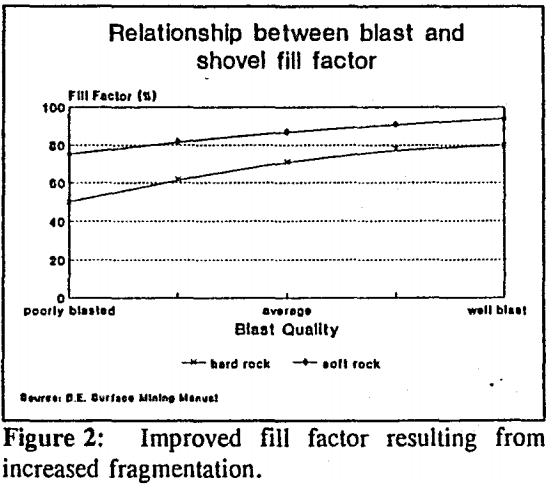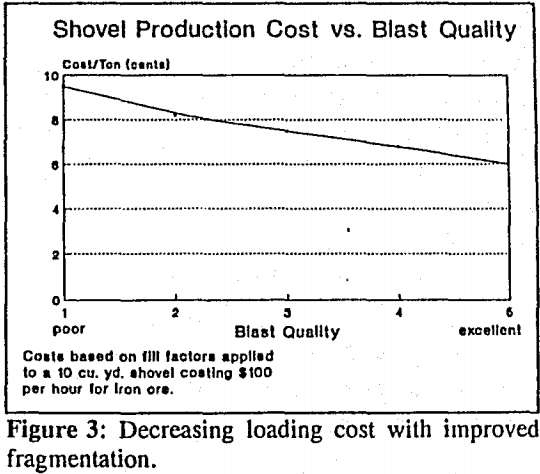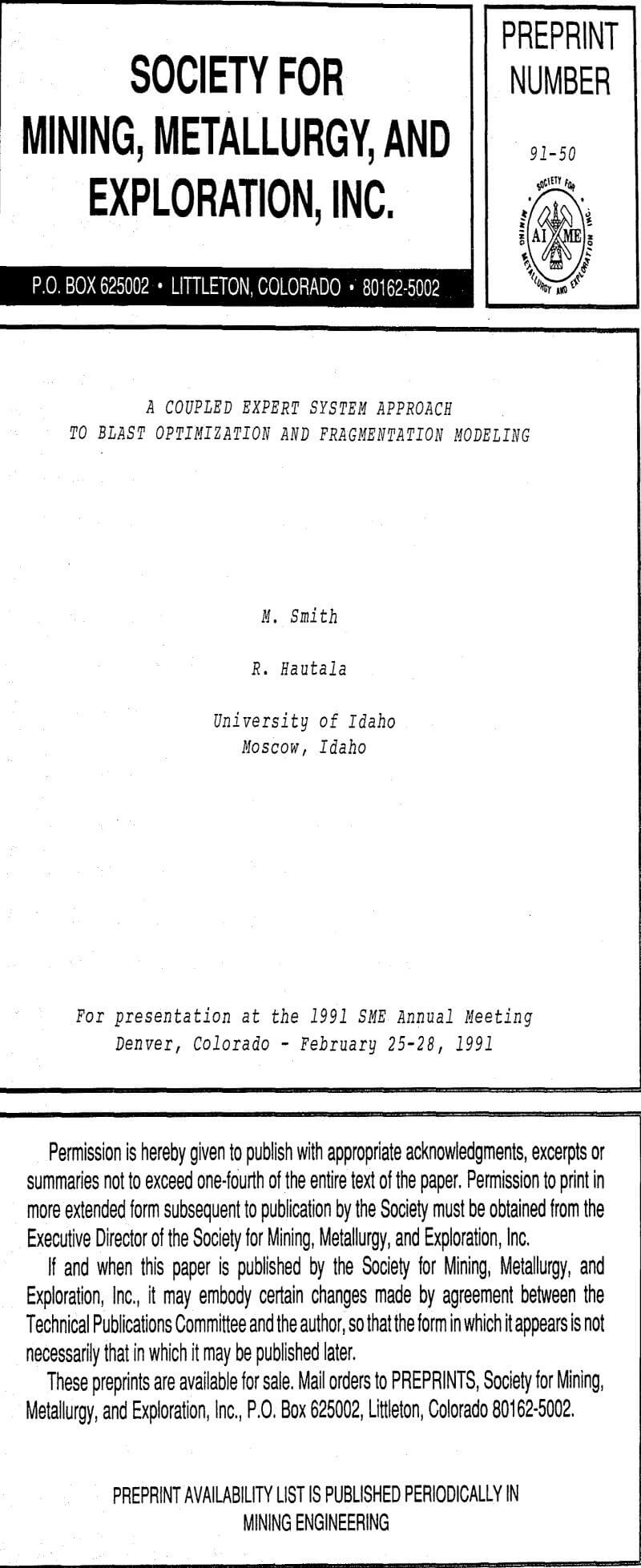Table of Contents
Blasting plays a key role in all facets of operations. Obviously, drilling and blasting costs are determined by blast design, but the downstream costs that are closely related to blasting results are often treated as separate functions: loading, hauling, cleanup, and crushing and grinding are all heavily influenced. Diggability and bucket fill factor are a function of fragmentation, the condition of the floor and uniformity in the shape of the muck pile. Likewise, cycle times and loading delays partially determine haul cycles, while fragmentation distribution and size determines the efficiency of truck loading. Removal and breakage of oversize causes loading delays and increases cleanup costs. The influence of blasting doesn’t stop at the crusher. Mill productivity, power consumption, and maintenance are a function of the feed.
Modelling Blast Fragmentation
The common denominator in all models of fragmentation is the influence of rock properties and geologic structures within the blast. A simulation approach which attempts to accurately replicate the fragmentation process will necessarily be complex and difficult to apply to a wide variety of geologically dissimilar sites. The Kuznetzov equation has the advantages of being well suited to statistical fitting to general rock conditions and blast design. Combining this with a Rosin-Rammler type distribution adds the known accuracy of existing comminution models.
The Kunetzov equation was developed to predict the mean fragment size based on a generic rock competency factor and the energy factor of the explosive. This is,

where, A is a rock factor related to the degree of hardness and jointing. Cunningham (1987) has revised this factor to be a function of qualitative descriptors for rock mass characteristics paying special attention to jointing, density and hardness.
Vo is the rock volume broken per blast hole (burden x spacing x bench height)
Q (kg) mass of TNT equivalent explosive per blast hole (excluding load in subdrill area)
A large body of research as been conducted on rate processes in comminution. Here, models are developed to determine the mass/particle size distribution of a crushing or grinding process based on the input feed distribution and rock and mill characteristics. These models are an accurate and accepted tool in designing crushing and grinding circuits. By sampling both the feed and product from a size reduction mechanism a transformation matrix can be developed relating input to output for that process. Thus, at any point in the circuit the product size distribution can be back-transformed to determine the input feed. Ultimately, this methodology can be used to determine input to the primary crusher, i.e., blast fragmentation distribution.
Optimization of Unit Operations
Cost analysis of unit operations to minimize unit cost based on degree of fragmentation. This technique is representative of the trial and error approach used in well-managed mines in the last three decades. The disadvantage inherent in this method is the high cost involved in full scale blasts in which blast design parameters are varied and the impact of changes in fragmentation, muck pile profile, and diggability are measured in terms of increased costs in all unit operations. This type of on-site sensitivity analysis will yield the most accurate results, but is usually prohibitively expensive and even disruptive. Also, due to changes over time in geology (location in the pit), equipment, and length of haul, this type of analysis may need to be repeated throughout the mine’s life.

.




Optimization of Fragmentation in an Underground Mine
Rock from underground mining has a size-distribution, that varies from mine to mine, depends on rock conditions and mining method and on how much explosives etc, that is used.
Because at the high costs, associated with full-scale studies of the size-distribution of blasted rock in a mine, detailed information is seldom published about such size-distributions. However, some facts can be noticed.
Rock from tunnelling and other types of development work has a fine fragmentation. Cut-and-fill mining is a method that normally results in blasted rock with an advantageous size distribution.
Block caving on the other hand often results in large amounts of boulders, since blasting of the rock is normally not used.
It is clear that the relationship between fragmentation and costs varies strongly from mine to mine. However, there are some consequences that must be taken into account, when one consider a change in the fragmentation of blasted rock in an underground mine. A better fragmentation means:
- More drilling and blasting is required
- Less time and money must be spent on elimination of boulders by secondary blasting or other methods
- Capacities for loaders, trucks, trains etc will increase and the corresponding costs thus decrease
- Less disturbances in mine production, which means less development work, fewer muck-piles, fewer draw-points etc to guarantee ore production
- Cost savings in ore benefiction, especially primary crushing
- Elimination of primary crushing before conveyor- and skiphoisting systems, if fragmentation is very fine.
In this study, five different size-distributions or degrees of fragmentation will be studied; with
k50 = 0.05, 0.1, 0.2, 0.3 or 0.4 meter
The size-distributions can be further described by formulas, developed by the Swedish Blasting Research Foundation, (SveDeFo) where;

k50 = average size of blasted rock
V = spacing, meters
E = Hole Distance, meters
q = Powder factor, kg/m³ rock
c = Constant (=0.5 in this study)

y = 1-e
X = Size of rock, meters
y = Per cent of rock less than X meters
To get the minimal hole-diameter required, the following formula will be used:
q = (D/2)² x 3.14 x P x 1000/1.25 x V²
where:
D = hole diameter
P = density of explosive inhole
E/V= 1.25
So far, only drilling and blasting have been considered. To find the best size distribution or fragmentation in blasted ore, other costs like loading and haulage costs must also be studied.
To find the optimal fragmentation, one must compare the total cost for drilling, blasting, mucking, haulage, boulder elimination, capital and development-cost and ore benefication cost for each size-distribution.
The size-distribution that yields the lowest total cost per ton of ore mined, represents the optimal size-distribution. Besides there are some other factors, that must be remembered, such as the risk for blasting damages, if much explosive is used.
Boulders coarse problems at the muck pile, in chutes, in crushers etc and must often be treated. As mentioned earlier, it is assumed that all pieces of rock larger than 700 millimeters must be taken care of somewhere in the mine by secondary blasting or other methods.









Comparison of Costs of Mechanical and Explosive Comminution
The comminution process at an open pit operation starts with the drilling of blast holes and ends after the material has gone through the fine grind circuit. Operators usually break the process into several separate operations and do their cost analysis based on this approach. Often drilling and blasting is considered as one system and crushing and grinding are considered as one or two separate and independent systems. Operators will independently optimize each system. The cost for the drilling and blasting system is obvious in operations which use contract drillers to do the drilling and either contract the blasting to a distributor or do the blasting themselves. The cost of rock breaking in this manner is readily available since the contract driller will supply a monthly drilling cost to the operation and either the distributor who is contracting the blasting or the distributor who is supplying the powder to the blasting operation will also supply a monthly billing. In either case, the costs can easily be seen on a monthly or per ton basis. They are not difficult to compute even when drilling and blasting are done entirely in-house.
To further explore this concept of a total system cost let us compare the costs at a very simple operation such as an aggregate quarry where the rock must be drilled and blasted and run through a primary crusher. This approach may be more meaningful if we compare the cost at an actual operation.

